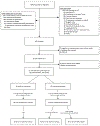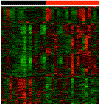Host and Bacterial Markers that Differ in Children with Cystitis and Pyelonephritis
- PMID: 30905425
- PMCID: PMC6535366
- DOI: 10.1016/j.jpeds.2019.01.012
Host and Bacterial Markers that Differ in Children with Cystitis and Pyelonephritis
Abstract
Objective: To determine whether treatment for urinary tract infections in children could be individualized using biomarkers for acute pyelonephritis.
Study design: We enrolled 61 children with febrile urinary tract infections, collected blood and urine samples, and performed a renal scan within 2 weeks of diagnosis to identify those with pyelonephritis. Renal scans were interpreted centrally by 2 experts. We measured inflammatory proteins in blood and urine using LUMINEX or an enzyme-linked immunosorbent assay. We evaluated serum RNA expression using RNA sequencing in a subset of children. Finally, for children with Escherichia coli isolated from urine cultures, we performed a polymerase chain reaction for 4 previously identified virulence genes.
Results: Urinary markers that best differentiated pyelonephritis from cystitis included chemokine (C-X-C motif) ligand (CXCL)1, CXCL9, CXCL12, C-C motif chemokine ligand 2, INF γ, and IL-15. Serum procalcitonin was the best serum marker for pyelonephritis. Genes in the interferon-γ pathway were upregulated in serum of children with pyelonephritis. The presence of E coli virulence genes did not correlate with pyelonephritis.
Conclusions: Immune response to pyelonephritis and cystitis differs quantitatively and qualitatively; this may be useful in differentiating these 2 conditions.
Keywords: UTI; calculator; diagnostic accuracy; prediction rule; risk.
Copyright © 2019 Elsevier Inc. All rights reserved.
Figures


References
-
- Jantausch BA, Wiedermann BL, Hull SI, Nowicki B, Getson PR, Rushton HG, et al. Escherichia coli virulence factors and 99mTc-dimercaptosuccinic acid renal scan in children with febrile urinary tract infection. Pediatr Infect Dis J 1992;11:343–9. - PubMed
-
- Majd M, Rushton HG, Chandra R, Andrich MP, Tardif CP, Rashti F. Technetium-99m-DMSA renal cortical scintigraphy to detect experimental acute pyelonephritis in piglets: comparison of planar (pinhole) and SPECT imaging.[see comment]. J Nucl Med 1996;37:1731–4. - PubMed
-
- Rushton HG, Majd M, Chandra R, Yim D. Evaluation of 99mtechnetium-dimercapto-succinic acid renal scans in experimental acute pyelonephritis in piglets. J Urol 1988; 140:1169–74. - PubMed
-
- Andrews S Fast QC http://www.bioinformatics.babraham.ac.uk/projects/fastqc/2016[
Publication types
MeSH terms
Substances
Grants and funding
LinkOut - more resources
Full Text Sources
Medical
Research Materials

